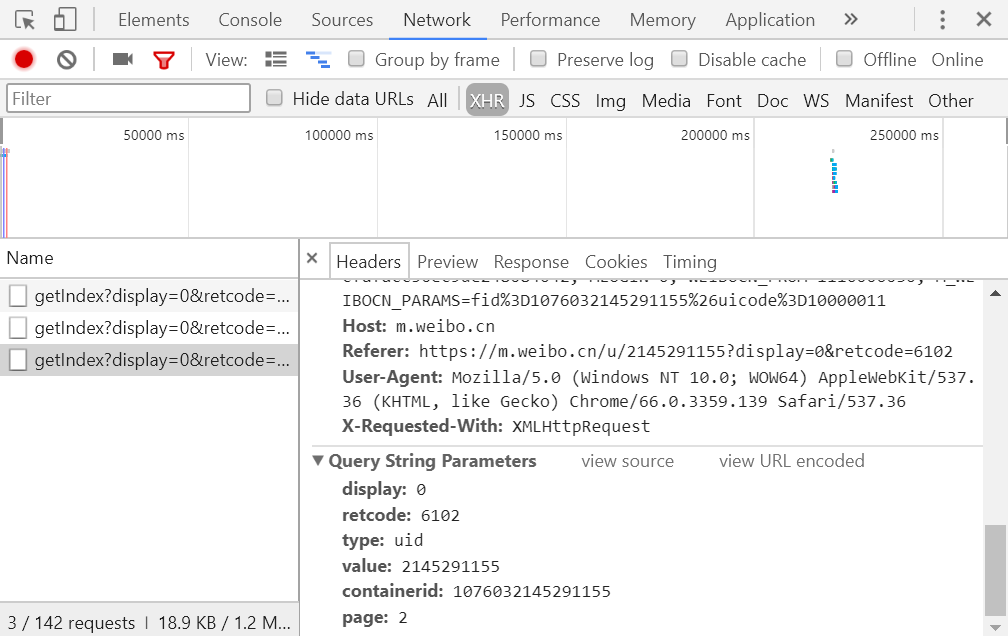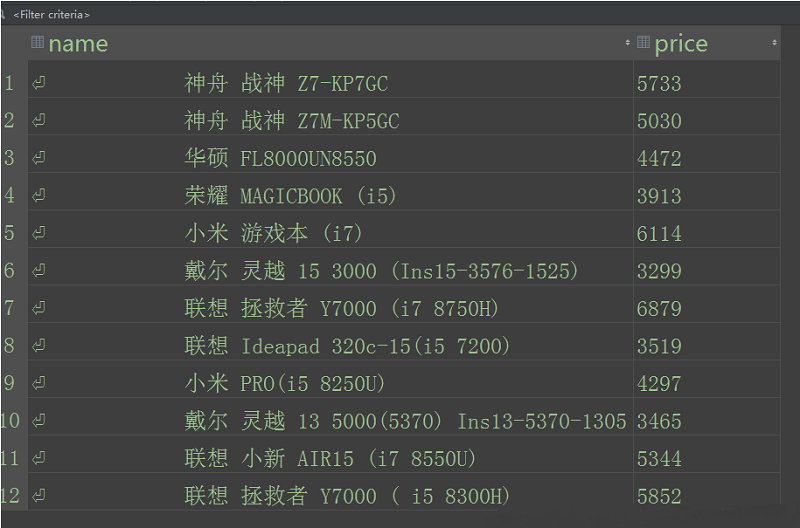python Selenium爬取内容并存储至MySQL数据库的实现代码
前面我通过一篇文章讲述了如何爬取CSDN的博客摘要等信息。通常,在使用Selenium爬虫爬取数据后,需要存储在TXT文本中,但是这是很难进行数据处理和数据分析的。这篇文章主要讲述通过Selenium爬取我的个人博客信息,然后存储在数据库MySQL中,以便对数据进行分析,比如分析哪个时间段发表的博客多、结合WordCloud分析文章的主题、文章阅读量排名等。
这是一篇基础性的文章,希望对您有所帮助,如果文章中出现错误或不足之处,还请海涵。下一篇文章会简单讲解数据分析的过程。
一. 爬取的结果
爬取的地址为:http://blog.csdn.net/Eastmount
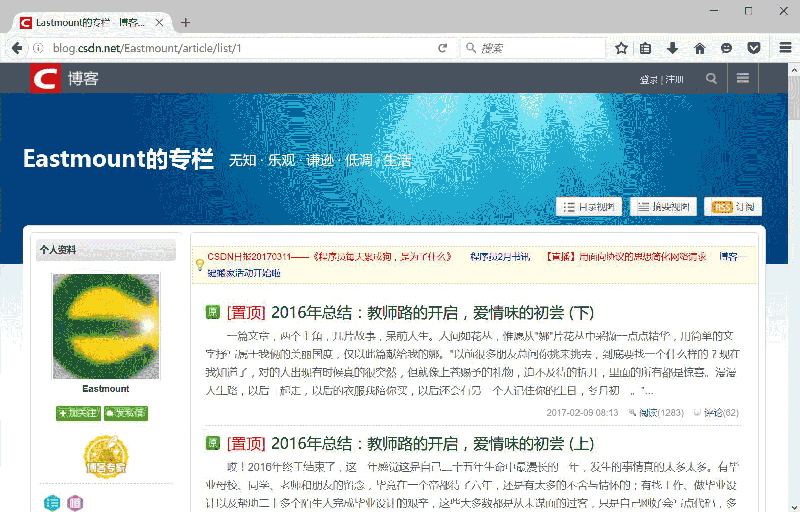
爬取并存储至MySQL数据库的结果如下所示:
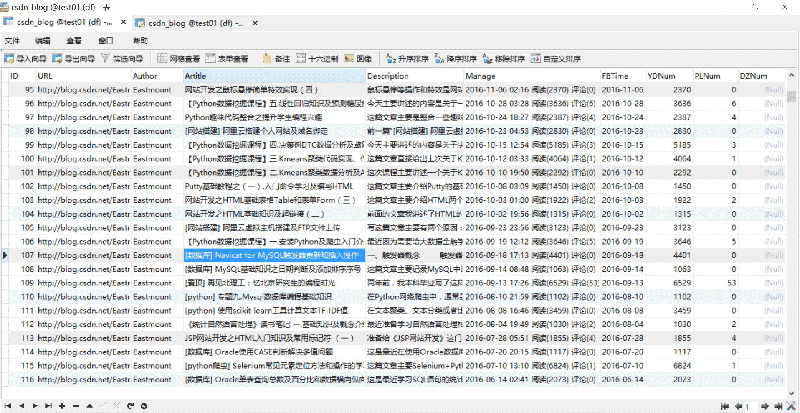
运行过程如下图所示:
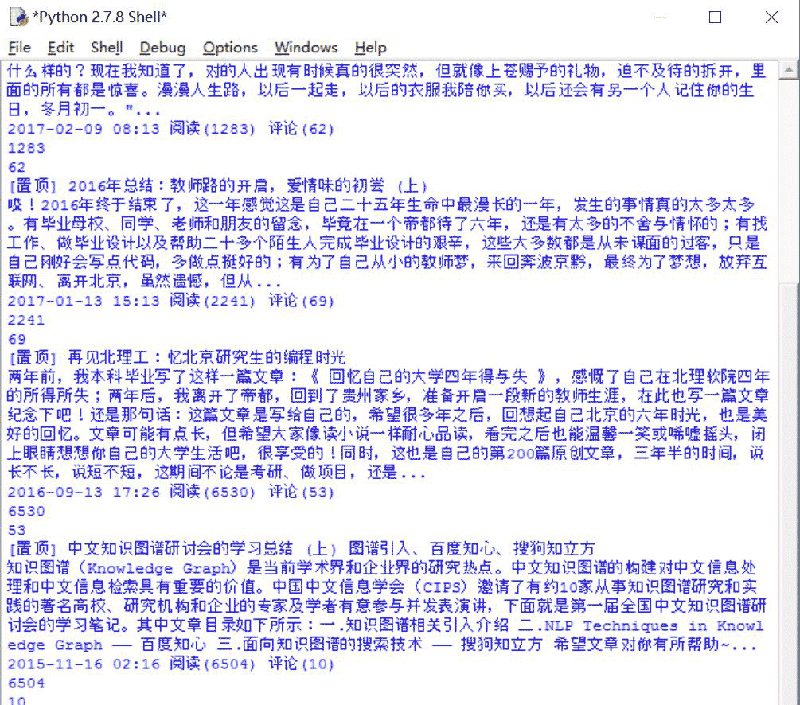
二. 完整代码分析
完整代码如下所示:
# coding=utf-8
from selenium import webdriver
from selenium.webdriver.common.keys import Keys
import selenium.webdriver.support.ui as ui
import re
import time
import os
import codecs
import MySQLdb
#打开Firefox浏览器 设定等待加载时间
driver = webdriver.Firefox()
wait = ui.WebDriverWait(driver,10)
#获取每个博主的博客页面低端总页码
def getPage():
print 'getPage'
number = 0
texts = driver.find_element_by_xpath("//div[@id='papelist']").text
print '页码', texts
m = re.findall(r'(\w*[0-9]+)\w*',texts) #正则表达式寻找数字
print '页数:' + str(m[1])
return int(m[1])
#主函数
def main():
#获取txt文件总行数
count = len(open("Blog_URL.txt",'rU').readlines())
print count
n = 0
urlfile = open("Blog_URL.txt",'r')
#循环获取每个博主的文章摘信息
while n < count: #这里爬取2个人博客信息,正常情况count个博主信息
url = urlfile.readline()
url = url.strip("\n")
print url
driver.get(url)
#获取总页码
allPage = getPage()
print u'页码总数为:', allPage
time.sleep(2)
#数据库操作结合
try:
conn=MySQLdb.connect(host='localhost',user='root',
passwd='123456',port=3306, db='test01')
cur=conn.cursor() #数据库游标
#报错:UnicodeEncodeError: 'latin-1' codec can't encode character
conn.set_character_set('utf8')
cur.execute('SET NAMES utf8;')
cur.execute('SET CHARACTER SET utf8;')
cur.execute('SET character_set_connection=utf8;')
#具体内容处理
m = 1 #第1页
while m <= allPage:
ur = url + "/article/list/" + str(m)
print ur
driver.get(ur)
#标题
article_title = driver.find_elements_by_xpath("//div[@class='article_title']")
for title in article_title:
#print url
con = title.text
con = con.strip("\n")
#print con + '\n'
#摘要
article_description = driver.find_elements_by_xpath("//div[@class='article_description']")
for description in article_description:
con = description.text
con = con.strip("\n")
#print con + '\n'
#信息
article_manage = driver.find_elements_by_xpath("//div[@class='article_manage']")
for manage in article_manage:
con = manage.text
con = con.strip("\n")
#print con + '\n'
num = 0
print u'长度', len(article_title)
while num < len(article_title):
#插入数据 8个值
sql = '''insert into csdn_blog
(URL,Author,Artitle,Description,Manage,FBTime,YDNum,PLNum)
values(%s, %s, %s, %s, %s, %s, %s, %s)'''
Artitle = article_title[num].text
Description = article_description[num].text
Manage = article_manage[num].text
print Artitle
print Description
print Manage
#获取作者
Author = url.split('/')[-1]
#获取阅读数和评论数
mode = re.compile(r'\d+\.?\d*')
YDNum = mode.findall(Manage)[-2]
PLNum = mode.findall(Manage)[-1]
print YDNum
print PLNum
#获取发布时间
end = Manage.find(u' 阅读')
FBTime = Manage[:end]
cur.execute(sql, (url, Author, Artitle, Description, Manage,FBTime,YDNum,PLNum))
num = num + 1
else:
print u'数据库插入成功'
m = m + 1
#异常处理
except MySQLdb.Error,e:
print "Mysql Error %d: %s" % (e.args[0], e.args[1])
finally:
cur.close()
conn.commit()
conn.close()
n = n + 1
else:
urlfile.close()
print 'Load Over'
main()
在Blog_Url.txt文件中放置需要爬取用户的博客地址URL,如下图所示。注意在此处,作者预先写了个爬取CSDN所有专家的URL代码,这里为访问其他人用于提升阅读量已省略。
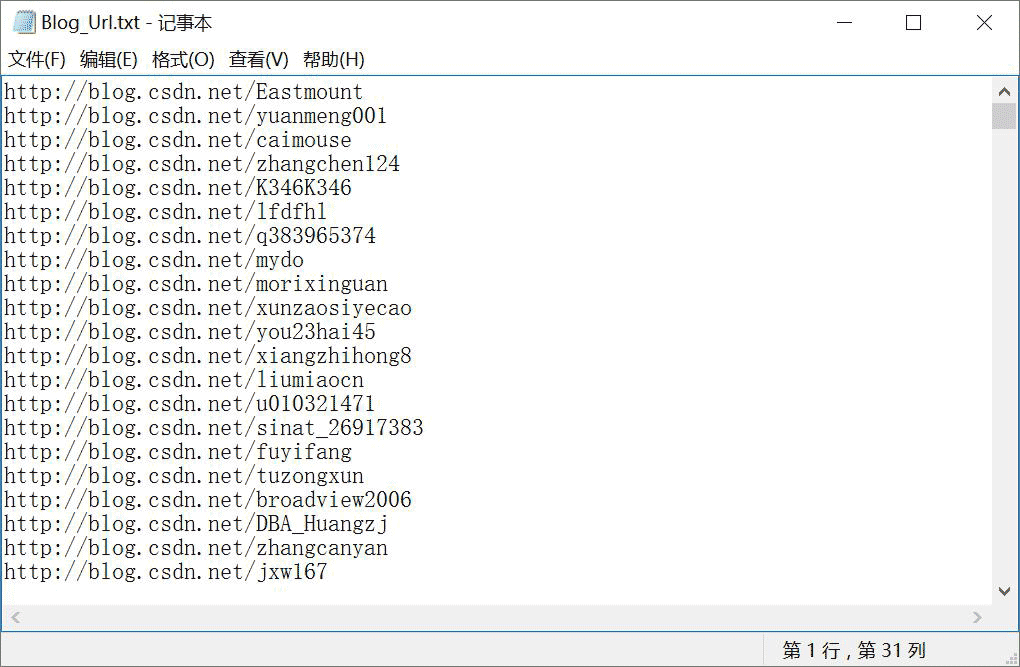
分析过程如下所示。
1.获取博主总页码
首先从Blog_Url.txt读取博主地址,然后访问并获取页码总数。代码如下:
#获取每个博主的博客页面低端总页码
def getPage():
print 'getPage'
number = 0
texts = driver.find_element_by_xpath("//div[@id='papelist']").text
print '页码', texts
m = re.findall(r'(\w*[0-9]+)\w*',texts) #正则表达式寻找数字
print '页数:' + str(m[1])
return int(m[1])
比如获取总页码位17页,如下图所示:
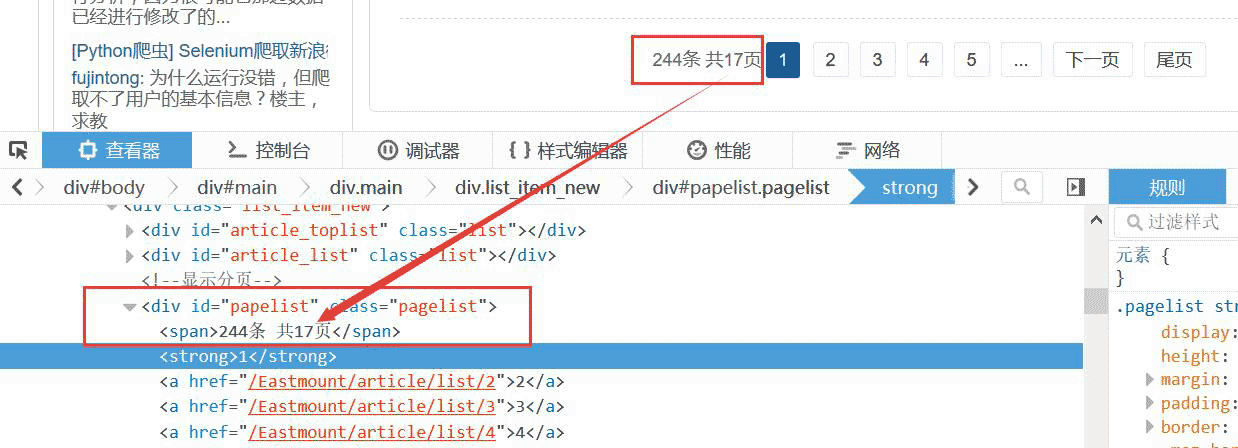
2.翻页DOM树分析
这里的博客翻页采用的是URL连接,比较方便。
如:http://blog.csdn.net/Eastmount/article/list/2
故只需要 :1.获取总页码;2.爬取每页信息;3.URL设置进行循环翻页;4.再爬取。
也可以采用点击"下页"跳转,没有"下页"停止跳转,爬虫结束,接着爬取下一个博主。
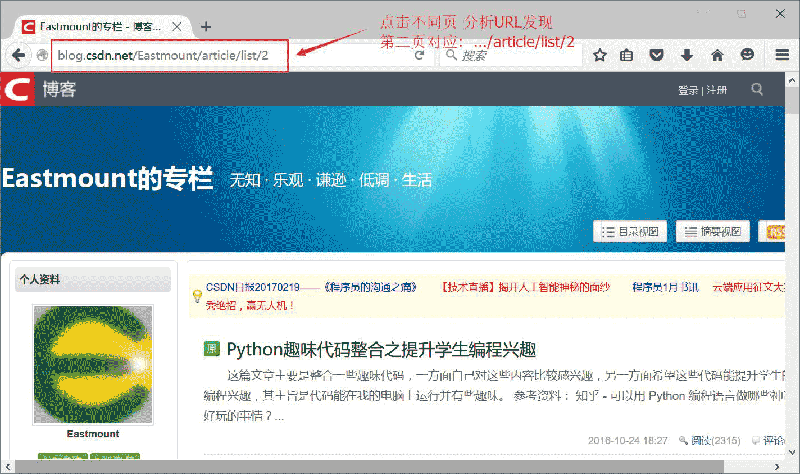
3.获取详细信息:标题、摘要、时间
然后审查元素分析每个博客页面,如果采用BeautifulSoup爬取会报错"Forbidden"。
发现每篇文章都是由一个<div></div>组成,如下所示,只需要定位到该位置即可。
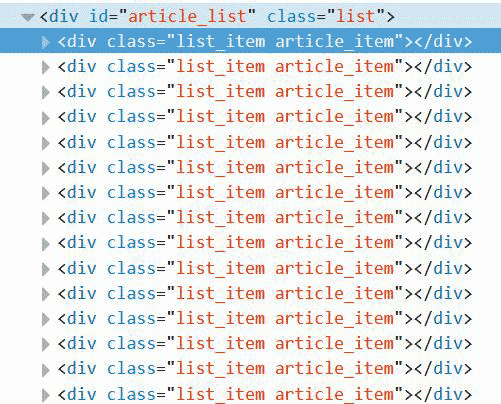
这里定位到该位置即可爬取,这里需要分别定位标题、摘要、时间。
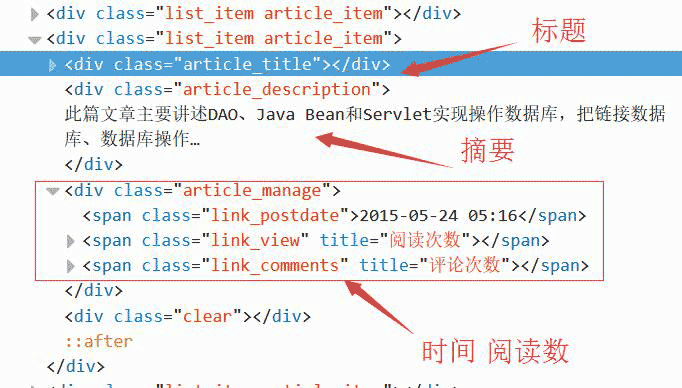
代码如下所示。注意,在while中同时获取三个值,它们是对应的。
#标题
article_title = driver.find_elements_by_xpath("//div[@class='article_title']")
for title in article_title:
con = title.text
con = con.strip("\n")
print con + '\n'
#摘要
article_description = driver.find_elements_by_xpath("//div[@class='article_description']")
for description in article_description:
con = description.text
con = con.strip("\n")
print con + '\n'
#信息
article_manage = driver.find_elements_by_xpath("//div[@class='article_manage']")
for manage in article_manage:
con = manage.text
con = con.strip("\n")
print con + '\n'
num = 0
print u'长度', len(article_title)
while num < len(article_title):
Artitle = article_title[num].text
Description = article_description[num].text
Manage = article_manage[num].text
print Artitle, Description, Manage
4.特殊字符串处理
获取URL最后一个/后的博主名称、获取字符串时间、阅读数代码如下:
#获取博主姓名
url = "http://blog.csdn.net/Eastmount"
print url.split('/')[-1]
#输出: Eastmount
#获取数字
name = "2015-09-08 18:06 阅读(909) 评论(0)"
print name
import re
mode = re.compile(r'\d+\.?\d*')
print mode.findall(name)
#输出: ['2015', '09', '08', '18', '06', '909', '0']
print mode.findall(name)[-2]
#输出: 909
#获取时间
end = name.find(r' 阅读')
print name[:end]
#输出: 2015-09-08 18:06
import time, datetime
a = time.strptime(name[:end],'%Y-%m-%d %H:%M')
print a
#输出: time.struct_time(tm_year=2015, tm_mon=9, tm_mday=8, tm_hour=18, tm_min=6,
# tm_sec=0, tm_wday=1, tm_yday=251, tm_isdst=-1)
三. 数据库相关操作
SQL语句创建表代码如下:
CREATE TABLE `csdn` ( `ID` int(11) NOT NULL AUTO_INCREMENT, `URL` varchar(100) COLLATE utf8_bin DEFAULT NULL, `Author` varchar(50) COLLATE utf8_bin DEFAULT NULL COMMENT '作者', `Artitle` varchar(100) COLLATE utf8_bin DEFAULT NULL COMMENT '标题', `Description` varchar(400) COLLATE utf8_bin DEFAULT NULL COMMENT '摘要', `Manage` varchar(100) COLLATE utf8_bin DEFAULT NULL COMMENT '信息', `FBTime` datetime DEFAULT NULL COMMENT '发布日期', `YDNum` int(11) DEFAULT NULL COMMENT '阅读数', `PLNum` int(11) DEFAULT NULL COMMENT '评论数', `DZNum` int(11) DEFAULT NULL COMMENT '点赞数', PRIMARY KEY (`ID`) ) ENGINE=InnoDB AUTO_INCREMENT=9371 DEFAULT CHARSET=utf8 COLLATE=utf8_bin;
显示如下图所示:
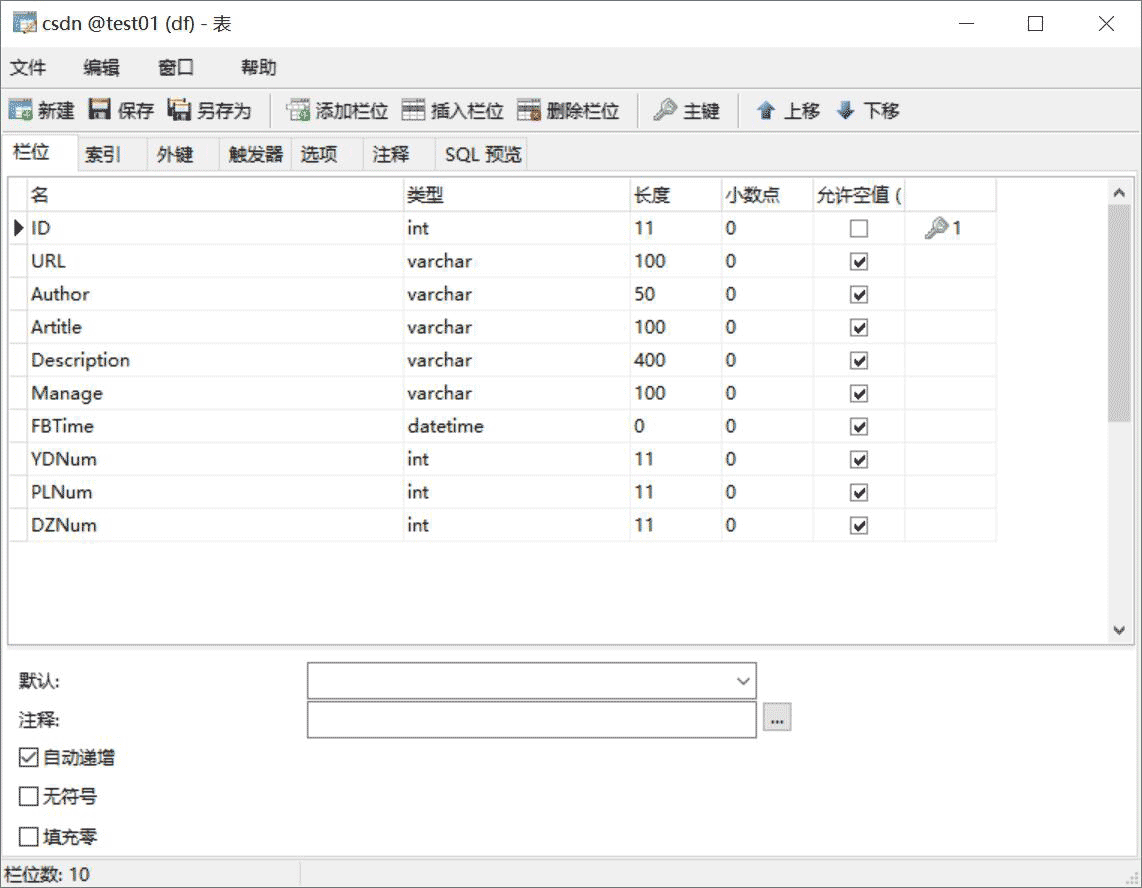
其中,Python调用MySQL推荐下面这篇文字。
python专题九.Mysql数据库编程基础知识
核心代码如下所示:
# coding:utf-8
import MySQLdb
try:
conn=MySQLdb.connect(host='localhost',user='root',passwd='123456',port=3306, db='test01')
cur=conn.cursor()
#插入数据
sql = '''insert into student values(%s, %s, %s)'''
cur.execute(sql, ('yxz','111111', '10'))
#查看数据
print u'\n插入数据:'
cur.execute('select * from student')
for data in cur.fetchall():
print '%s %s %s' % data
cur.close()
conn.commit()
conn.close()
except MySQLdb.Error,e:
print "Mysql Error %d: %s" % (e.args[0], e.args[1])
注意,在下载过程中,有的网站是新版本的,无法获取页码。
比如:http://blog.csdn.net/michaelzhou224
这时需要简单设置,跳过这些链接,并保存到文件中,核心代码如下所示:
#获取每个博主的博客页面低端总页码
def getPage():
print 'getPage'
number = 0
#texts = driver.find_element_by_xpath("//div[@id='papelist']").text
texts = driver.find_element_by_xpath("//div[@class='pagelist']").text
print 'testsss'
print u'页码', texts
if texts=="":
print u'页码为0 网站错误'
return 0
m = re.findall(r'(\w*[0-9]+)\w*',texts) #正则表达式寻找数字
print u'页数:' + str(m[1])
return int(m[1])
主函数修改:
error = codecs.open("Blog_Error.txt", 'a', 'utf-8')
#循环获取每个博主的文章摘信息
while n < count: #这里爬取2个人博客信息,正常情况count个博主信息
url = urlfile.readline()
url = url.strip("\n")
print url
driver.get(url+"/article/list/1")
#print driver.page_source
#获取总页码
allPage = getPage()
print u'页码总数为:', allPage
#返回错误,否则程序总截住
if allPage==0:
error.write(url + "\r\n")
print u'错误URL'
continue; #跳过进入下一个博主
time.sleep(2)
#数据库操作结合
try:
.....
最后希望文章对你有所帮助,如果文章中存在错误或不足之处,还请海涵~
提高效率,提升科研,认真教学,娜美人生。
